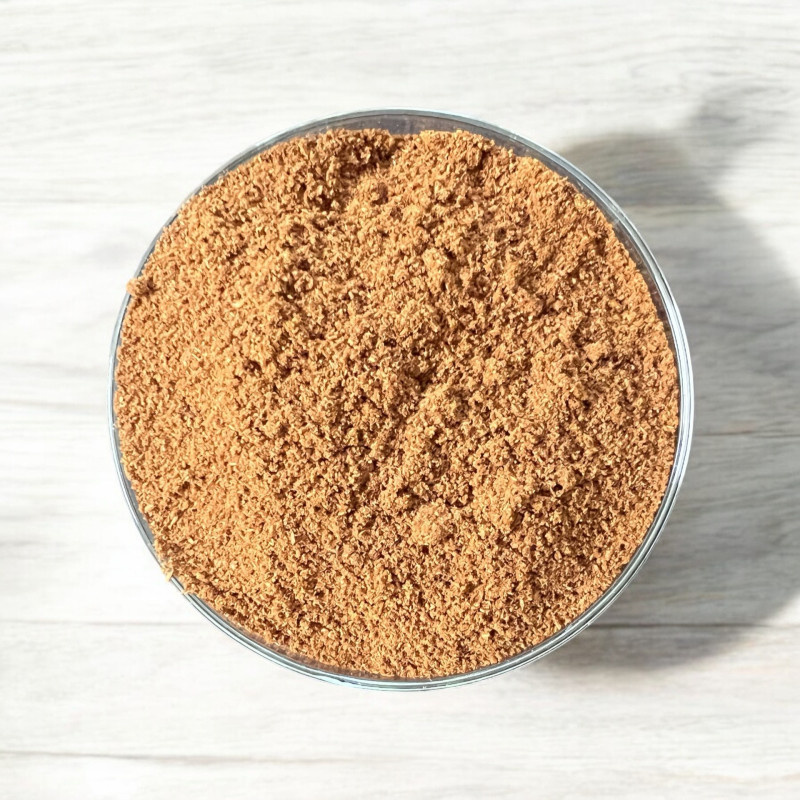
Reference: anisvertM


The entire fruit is ground into this strongly aromatic star anise powder.
You can use it in pastries (including gingerbread), fish dishes, and sauces. It will instantly infuse them with its rich flavor.
 Delivery
Delivery
Mondial Relay
 Returns
Returns
See conditions
 Payments
Payments
100% secure
Livré en sachet refermable
Uses in Cooking and Beyond:
Its aroma, more potent than that of green anise, is primarily due to the anethole contained in star anise.
As a powder, its fragrance is released immediately. It enhances pastries, including gingerbread, fish sauces (often with ginger), and wonderfully flavors mussels in marinieres, where whole stars wouldn't have time to impart their flavor.
Whole, star anise is often used in Europe for macerations in the production of alcoholic beverages (like pastis and ouzo). In baking, it is used either as a powder or infused whole in warm milk or other liquids. It's also excellent in certain jams (such as melon), and pairs well with fish. For those who enjoy its taste, whole star anise can be infused into fruit salads, or powdered and sprinkled on top.
After use, the whole star anise can be rinsed, dried, and used in potpourri or home decor. It can be left in its natural state or sprayed gold, for example, during the holiday season.
In infusion, star anise helps reduce bloating by aiding digestion. It is also an active component in Tamiflu, an antiviral known to combat human, avian, and swine flus.
Who am I?
Origin: China
Scientific name: Illicium verum Hook
Common names: Siberian anise, Chinese fennel
The fruit is beautiful, with its warm brown color and shiny seeds inside the "stars," exuding a delightful anise aroma!
It comes from a tropical shrub in the Magnoliaceae family, known as the Chinese star anise tree. About 90% of the world's production is harvested in China's Jiangxi province. The fruit consists of an eight-pointed star, each point containing a shiny seed. The tree is also found in Cambodia and Vietnam. It can grow up to 8 meters tall, with long, evergreen green leaves. The flowers are large and yellow. The fruit is harvested green and then sun-dried to a reddish-brown before being ground into powder. There are two harvests each year, in April and October.
There is also a Japanese star anise, which is banned from import into France due to its toxicity in high doses.
A Little History:
Star anise has been used in China since ancient times for its medicinal properties.
It was introduced to Europe during the time of Marco Polo and was used by practitioners of the era. However, its use did not become widespread until the Renaissance, when it was imported by the English.
In the Middle Ages, star anise was rare, highly coveted, and thus very expensive.
Data sheet
 DANIELE K.
DANIELE K.
Je l'ai utilisé pour des gâteaux de Noël à la cannelle & badiane. Je trouve que le goût n'est pas rendu.?

 DANIELE K.
DANIELE K.
Je l'ai utilisé pour des gâteaux de Noël à la cannelle & badiane. Je trouve que le goût n'est pas rendu.?

Reference: anisvertM
Reference: paindepices
Reference: pondichery
Reference: camomilleRom
Reference: baiepassion
Reference: 050721
Reference: ecorcecitronH
Reference: 6N7456401
Reference: 3N7137901
Reference: badianeE
Reference: bergamote
Reference: 10M6821604
Reference: 26545D
Reference: 3913
Reference: EPI230204
Reference: cardamomeverteE
Reference: 6470
Reference: SPW06600
Reference: 10N7738802

The entire fruit is ground into this strongly aromatic star anise powder.
You can use it in pastries (including gingerbread), fish dishes, and sauces. It will instantly infuse them with its rich flavor.